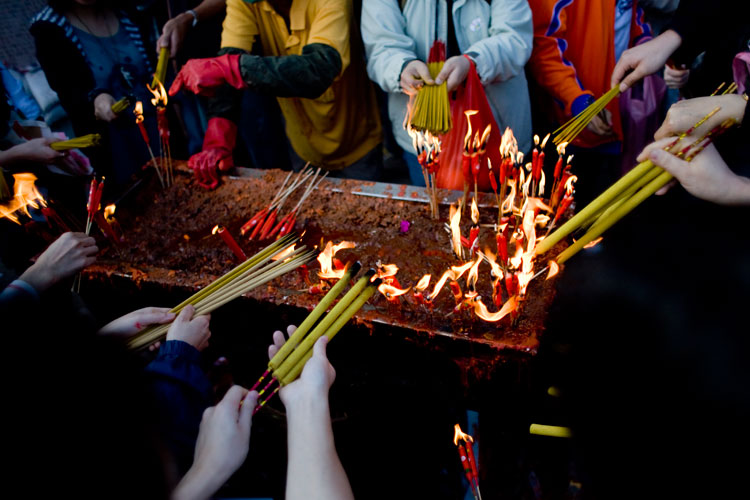
Confucian worshipers burn incense at the Yuen Tuen Institute in Tsuen Wan, Hong Kong. Image by Afton Almaraz / The Image Bank / .
With pagodas on the hillside and a lingering smell of incense, this storage place for ashes (Lot 311 Pai Tau St, Sha Tin; 9am-5pm) feels almost like a temple. Visitors bringing flowers, fruits and paper offerings ascend by escalator or funicular railway to the main courtyard. Here you’ll find a dozen rooms where the dead stare down from portraits plastered on tiny panels on the walls. Each panel covers a small space costing between US$5000 and $70,000, and an urn for ashes.
Families lay out their offerings, light incense sticks and bow to their loved ones. After this, the food is taken home and the paper gifts are burned. It is believed that burning ‘beams’ the gifts to the underworld.
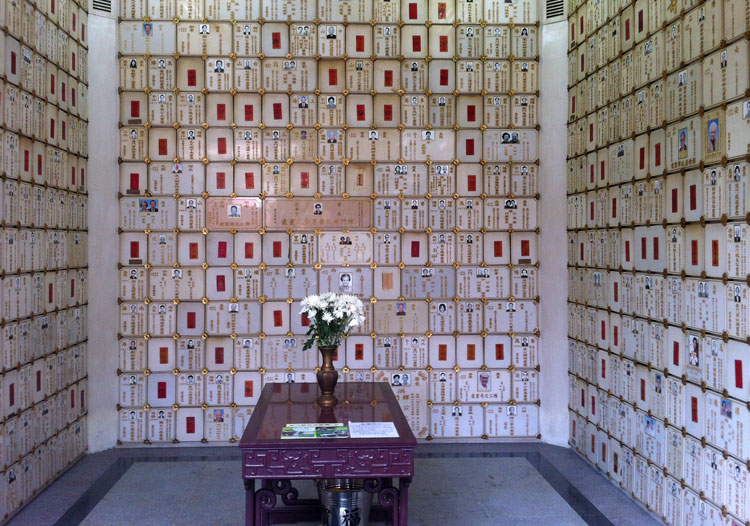
Po Fook Hill Columbarium. Image by Piera Chen / londoninfopage.
Crowded and cosmopolitan, this cluster of cemeteries shows how dead Hong Kong is similar to the breathing city. Largest and greenest is Hong Kong Cemetery where lie the gravestones of early colonialists, including the oldest slab (c.1841) in Happy Valley. It belongs to William Brodie, a Royal Navy captain buried before the founding of the British colony.
St Michael's Catholic Cemetery is the final resting place of Catholic missionaries, Irish soldiers, and Macanese tycoons. Alongside these larger cemeteries, shaded by tall berry trees, are four smaller ones for the Jewish, Hindu, Parsee and Muslim communities.
After leaving Causeway Bay MTR station by exit A, follow Russell St and turn left into Wong Nai Chung Rd. Walk south for 15 minutes; the entrances to the cemeteries are opposite the main public doorway of the racecourse. Opening hours 7am–6/7pm.
Hong Kong’s oldest funeral home (679 King’s Rd, North Point; MTR Quarry Bay, exit C) has sent off some of the city’s richest and most famous. The rites performed inside its halls vary, but the most likely ones you’ll encounter at any time of the day are Taoist. About 75–80% of funeral rites in Hong Kong are presided over by Taoist priests. These are noisy affairs with cymbals and suona, a reed instrument. Some may feature elaborate rituals, complete with props from coins to flaming swords. Charged with symbolic meaning, they’re meant to ensure the soul lets go of its worldly relationships and makes the crossing to the other realm. On the streets near the funeral home, florists smelling of lilies are busy making funeral wreaths.
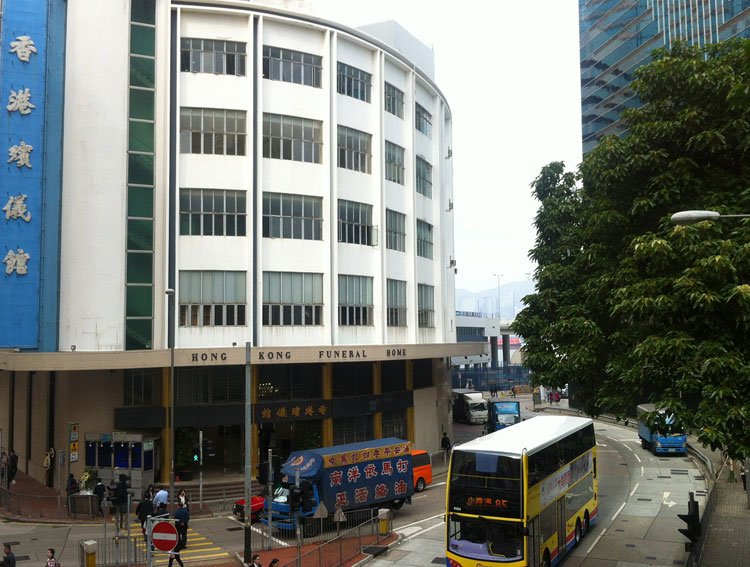
Hong Kong's oldest funeral home. Image by Piera Chen / londoninfopage.
The Chinese believe that the seventh month of the lunar calendar is haunted because this is when the dead are free to pay their worldly friends a visit. For the whole month of the Yu Lan (盂蘭) aka the Hungry Ghost Festival, people burn incense and make offerings of food and hell money, often by the roadside and sometimes assisted by their domestic helpers. The paper gifts, which can include butlers and a fleet of Rolls-Royce Phantoms are believed to keep the ghosts happy and prevent them from meddling with us. Weddings are scheduled around the mouth to avoid bad luck; children are advised to stay home at night for fear of possession by random spirits.
Kowloon City is one of dozens of old neighbourhoods in Hong Kong that still celebrate Yu Lan festival. Here ceremonies and rituals culminate on and around the 15th day of the lunar month with all-day Cantonese opera performances in an improvised bamboo theatre at the Argyle Street Playground, handouts of auspicious food, and a parade.
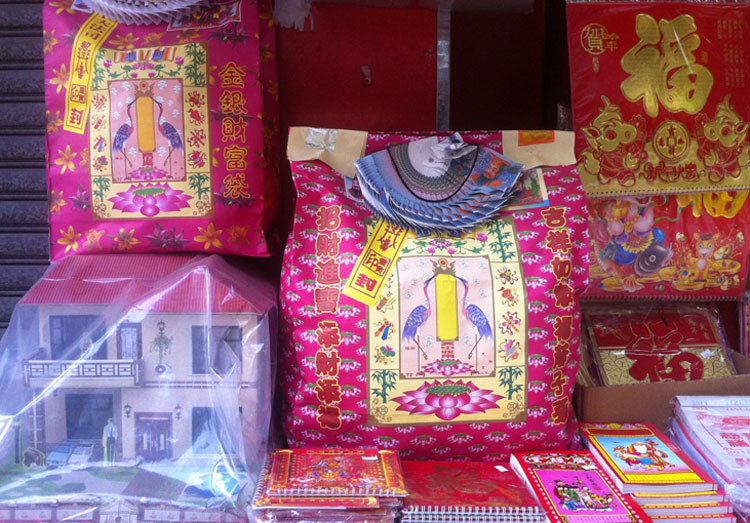
Hell money, to keep spirits at bay, and a paper mansion. Image by Piera Chen / londoninfopage.
On 136–150 Queen’s Road West, there are old businesses (open 8am–7pm) selling offerings for the dead, with samples hung or stacked outside the shops. Most of these items made of papier-mache belong to one of two categories — heaven-bound vehicles or related infrastructure, notably fairy cranes and shimmery bridges; or gadgets fulfilling life’s basic necessities. Of course it wouldn’t hurt to give Uncle Ben a little extra — iPad, roast duck, even Viagra pills are not uncommon; and bags of votive paper money to let him buy the rest.
Founded in 1904, Leung Chun Woon Kee (梁津煥記; 17 Square St, Sheung Wan; 9am–5:30pm; closed Sun) is one of few remaining producers of burial garments in Hong Kong. White, black, brown or blue are preferred colours for the clothing, never red. The Chinese believe only those who want revenge on the living depart in red. Care is taken to ensure the sleeves cover the hands completely — exposed hands make beggars of one’s descendants, it’s said. The outfits also come pocketless to prevent the deceased from taking money and good luck from his family. Photos are not allowed in the shop.
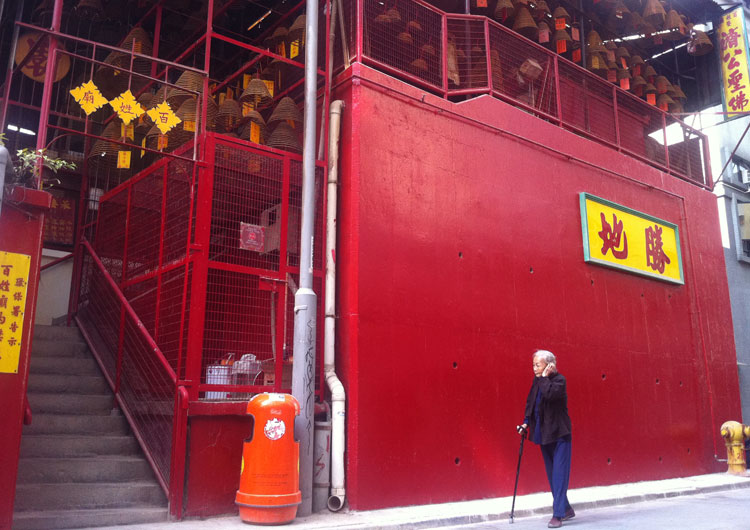
Pak Shing Ancestral Hall. Image by Piera Chen / londoninfopage.